Disclaimer: Participation in the survey was voluntary and anonymous. Students were informed that they could withdraw at any time and should only answer questions they felt comfortable with.
From maintaining grades to fostering relationships to simply finding time for oneself, it can feel impossible to keep up this juggling act of responsibilities. And now with newly reinstated midterms and finals, stress levels are through the roof. Or are they? RHS’s Psychology Club recently surveyed 54 students on a series of questions regarding their stress levels, and the results may surprise you.
1.) On Average, Students’ Daily Stress Levels Rank About 5.8/10
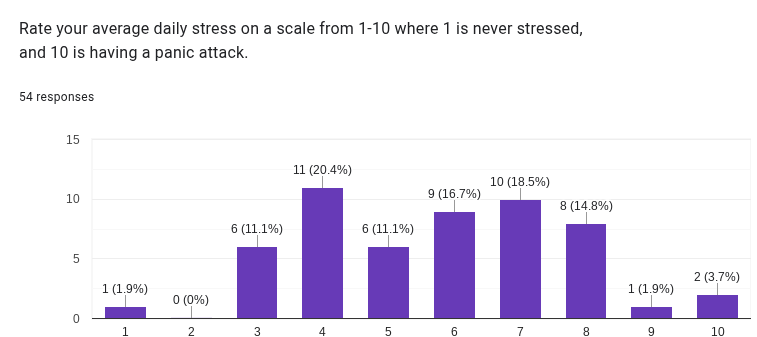
According to Yale Medicine, symptoms of chronic stress or “a consistent sense of feeling pressured and overwhelmed over a long period of time” can be classified into 4 categories: cognitive, emotional, physical, and behavioral. These may range from insomnia, to emotional withdrawal, or to changes in appetite or increased alcohol or drug use.
To reduce or even prevent stress, practice effective strategies such as:
- Eating healthier
- Learning time management techniques
- Making time to engage in leisure activities
- Mindfulness
2.) The Majority of Students Say School Is The Main Cause of Their Stress
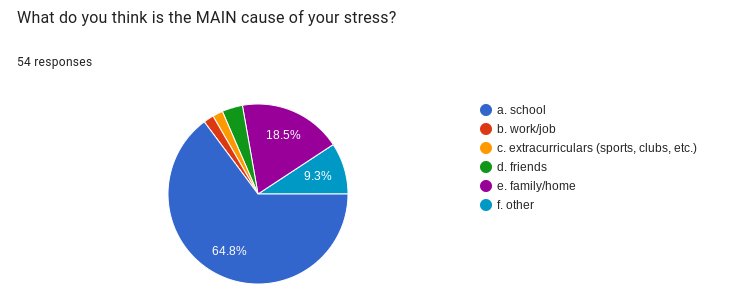
Perhaps unsurprisingly, school is the main stressor for most students — with deadlines, peer pressure, and a barrage of extracurricular responsibilities all striving for attention on the daily. Unfortunately, some of this stress also comes directly from family as well — even if they mean well. Maybe your parents demand that you take rigorous courses and become a star student or have constant arguments over how you “should” be acting.
While all households are different, some general tips to help manage tension at home are:
- Talk about what’s been bothering you
- Sticking to a routine
- Maintaining a healthy lifestyle (eating a balanced diet, exercising regularly, getting enough sleep, etc.)
3.) Overall, Students Are Slightly More Stressed At School Than At Home
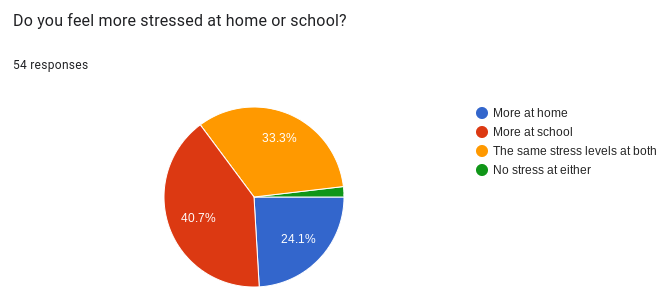
Environmental factors surrounding the home such as climate, poverty, and crime levels can significantly impact mental health. On top of this, at school, feeling connected to others, instruction clarity, and the strength of support systems may either positively or negatively impact students’ mental health.
At home, however, the environment can be more easily tailored to reduce stress by accommodating for individual needs. When dealing with a more public space where change may be difficult (I.e. School), focus on what you can control — such as creating a personal sanctuary to retreat to and recover from daily stressors.
4.) Having Lots Of Homework Is A Bigger Stressor Than Studying For One Test
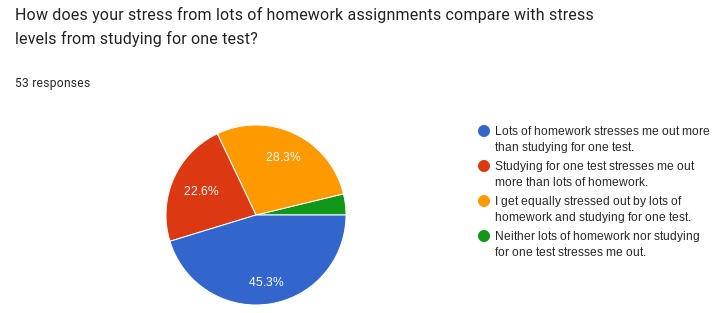
Having so many deadlines and responsibilities may lead to multitasking — defined as “working on two or more tasks simultaneously, switching back and forth from one thing to another, or performing a number of tasks in rapid succession.” Counterintuitive to popular belief, trying to accomplish multiple tasks at once may actually reduce productivity (as our brains aren’t designed to handle more than one task at a time) — causing distractions, slowing us down, and more mistakes — which ironically creates even more stress. Instead, try using the “20-minute rule,” where you devote your attention to a single task for 20 minutes before swapping to another.
5.) Half of Students Say They’re Burnt Out 2-3 Times a Week

Burnout — “a state of emotional, mental, and often physical exhaustion brought on by prolonged or repeated stress” — can quickly turn the compassionate into the apathetic if not carefully monitored. Oftentimes, schoolwork can feel meaningless — typically leading one to wonder “What’s the point of learning this anyways?” and “Will I ever use this again in my lifetime?”
To make trudging through the sea of endless work more bearable, connect it to something that gives you purpose and is meaningful to you. For example, by volunteering at the local animal shelter, one can also brush up on one’s writing skills by writing bios for each animal.
6.) Most Students Say Their Stress Level Slightly Negatively Impacts Their School Performance
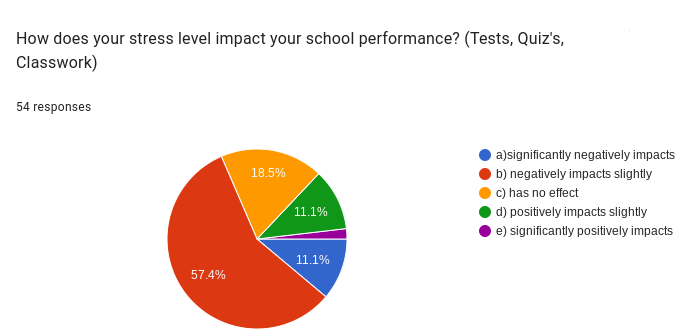
Contrary to popular belief, not all stress is detrimental — in fact, it can be beneficial depending on the situation! Negative stress (distress) is often what comes to mind regarding stress, defined as a feeling of being “overwhelmed, anxious, or worried due to challenging situations.” Typically arising from a perceived lack of control, distress can interfere in school performance as students may be begin to isolate themselves, lash out, and becoming dependent on negative coping mechanisms.
On the other hand, positive stress (eustress) comes from facing challenges — motivating and energizing a person to become excited about the outcome.To foster more eustress in your life, set and work toward goals — breaking down intimidating activities into bite-sized pieces — and afterwards, start new projects (or rather adventures).
7.) 46.3% of Students Participate in Physical Activities To Cope With Stress
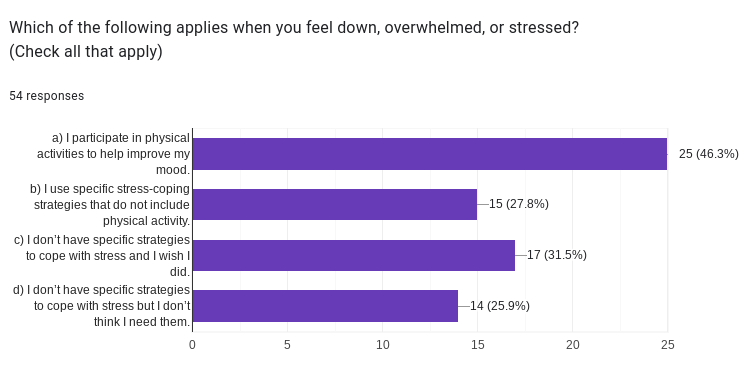
Physical activity is a great way to cope with stress — bringing many benefits such as energy boosts, a sense of achievement, decreased frustration, and increased focus and motivation. To enhance these benefits, exercising in nature — whether it be in a forest or noticing fauna on the roadside as you pass by — can reduce levels of depression and anxiety and boost happiness.
If that’s not your style though, there are plenty of other non-physical activities that are just as effective to relieving stress. From engaging in aromatherapy to receiving a hug from a loved one, experiment and find strategies that make you happy!
8.) Almost 90% Of Students Tend to Procrastinate
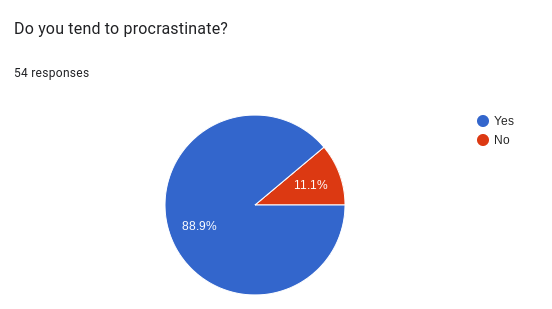
We’ve all been there — whether it be cramming for an exam for hours the night before or putting off homework in favor of scrolling through social media, procrastination is a plague that whispers in your ear lies such as “it won’t take that long” and “I’ll be more motivated later on.” However, in reality, that “right” time will never come. Procrastination itself can be split into 2 types: passive (delaying tasks due to trouble making and acting on decisions) and active (delaying tasks believing working under pressure allows them to feel “challenged and motivated”).
To defeat procrastination, some strategies you can try are:
- Make a to-do-list
- Eliminating distractions
- Reward yourself after finishing a task
Interestingly, the rare few who are “non-procrastinators” worry more about how they see themselves than how others see them. So instead of comparing yourself to others, compare yourself to past “yous.”
9.) Students Are Split Between Getting 7-8 Hours and 4-6 Hours of Sleep Per Night
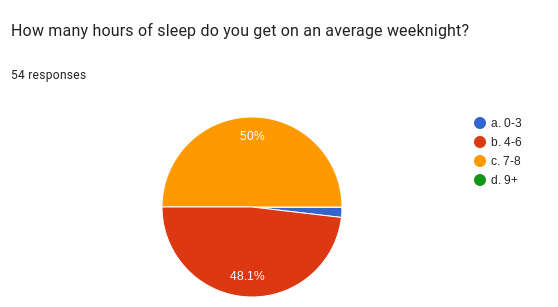
Whether it be because one was pulling an all-nighter to study or binging YouTube videos at 2 am, half of the student body isn’t getting the recommended amount of sleep for teens — typically being 8-10 hours a night according to the American Academy of Sleep Medicine. However, this isn’t entirely students’ fault as their circadian rhythm, a natural biological “clock” dictating when it’s time to sleep and wake up, shifts to signaling nighttime hours as a time to be awake, not asleep. Inevitably, these factors may snowball into constant sleep deprivation — not only affecting one’s ability to stay focused and learn, but also increasing the risk of developing chronic conditions such as diabetes and obesity.
To help whip your sleep schedule back into shape, consider distancing yourself from your phone (as light exposure can decrease melatonin, a sleep-inducing hormone) and replacing it with a regular alarm clock and sticking to a consistent sleep schedule every day (yes, even on weekends — no sleeping in!).
10.) The Majority of Students Say They Rarely Have Enough Time To Do What Needs To Be Done And Rest
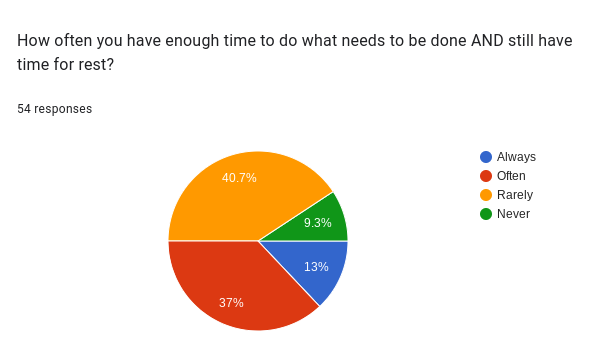
Work. Eat. Sleep. Repeat. This cycle is all too familiar for most, being expected to function as a robot and forget to live as a human. However, a constant lack of “me time” can lead one to become drained of creativity, allow anxiety and depression to take hold, and cause physical health to decline — such as developing skin disorders and heart disease.
Rather than let work dominate your every move, take back control of your life by developing healthy time management strategies such as:
- Logging/tracking how you spend your time
- Setting priorities
- Using a physical or digital planner on your phone
- Delegating tasks to others if needed
Although stress may be inevitable, with enough effort, stress can be transformed into the ultimate tool for success. All it takes is a little bit of work today to create a more manageable tomorrow.
